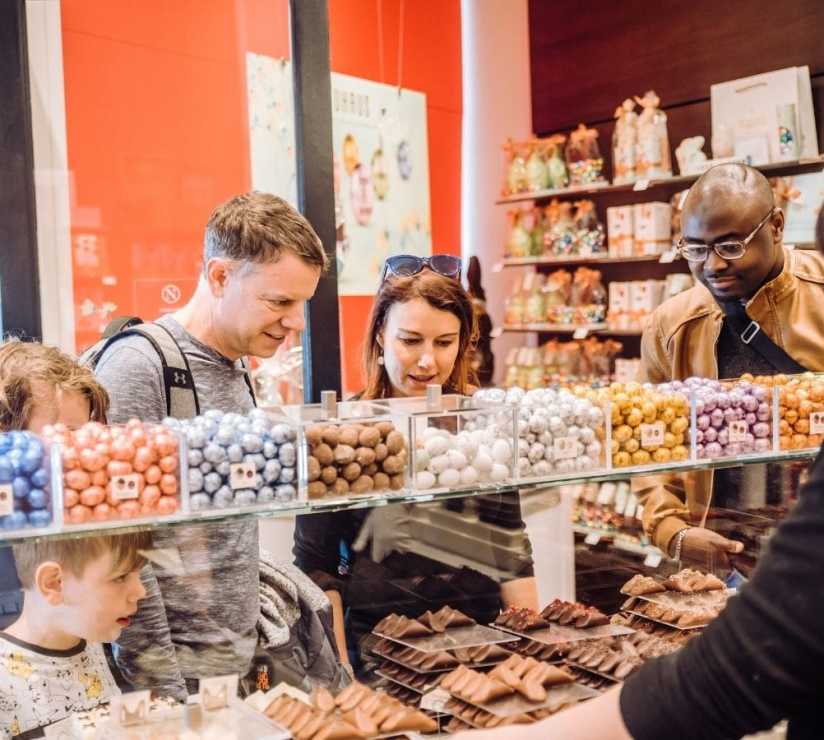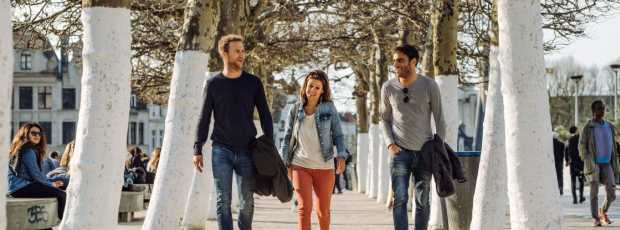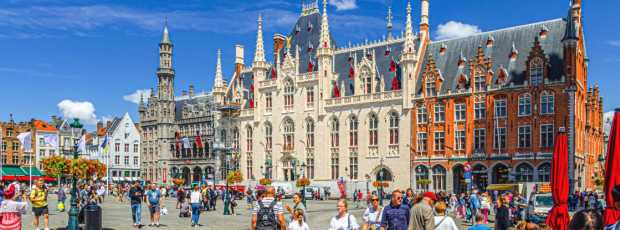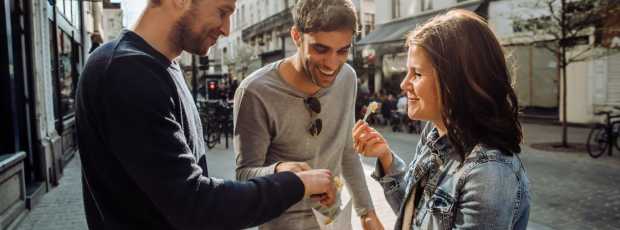Table Of Contents
- What Makes Grand Place More Than Just Another Square?
- Why Does Mont des Arts Matter to Modern Brussels?
- How Did Art Nouveau Architecture Shape Brussels?
- What Role Does the European Quarter Play in Brussels Identity?
- Why Should You Follow the Comic Strip Route?
- What's the Real Story Behind the Royal Palace and Belgian Parliament?
- How Do Manneken Pis and Jeanneke Pis Represent Brussels' Character?
- Why Is Parc du Cinquantenaire More Than Just a Park?
- What Makes Brussels' Chocolate and Waffles Worth the Hype?
- Where Can You Find Hidden Brussels Beyond the Tourist Trail?
- How Many Days Do You Need to Really Understand Brussels?
- What Time of Year Offers the Best Brussels Experience?
- How Should You Navigate Brussels as a First-Time Visitor?
- What Should You Expect from Brussels' Cultural Scene?
- Why Does Brussels Matter in Contemporary Europe?
- How Can You Make the Most of Your Brussels Experience?
- Conclusion: Why Brussels Sightseeing Offers More Than Expected
Brussels sightseeing often gets reduced to a checklist of monuments and a hurried hop between the Grand Place and Manneken Pis. Most visitors rush through the city's surface, missing the layers of history, politics, and culture that make Belgium's capital genuinely fascinating. The real Brussels experience emerges when you pause to understand why these places matter beyond their Instagram potential.
This city operates on multiple levels simultaneously. It's the de facto capital of Europe, a showcase of art nouveau architecture, and a living museum of Belgian quirks. The challenge isn't finding things to see, it's understanding what you're actually looking at.
What Makes Grand Place More Than Just Another Square?
The Grand Place, or Grote Markt in Dutch, anchors any serious Brussels exploration. This UNESCO World Heritage site functions as Brussels' political and commercial heart for over a millennium, and its architecture tells stories that guided walking tours typically skip.
Victor Hugo called it "the most beautiful square in the world," though he probably hadn't seen many. What makes the Grand Place genuinely remarkable is how it survived. The French bombardment of 1695 destroyed most of the medieval buildings, but the guilds rebuilt them with such architectural ambition that they created something more impressive than what existed before.
Each building represents a different guild, bakers, brewers, boatmen, and their facades compete for attention through increasingly elaborate baroque details. The town hall, begun in 1402, dominates the square with its asymmetrical spire.
The square transforms dramatically between day and night. During daylight hours, tourists cluster around the central cobblestones. After dark, the buildings receive careful illumination that reveals architectural details invisible during the day. This is when the Grand Place shows its true character, not as a museum piece, but as a living urban space that still hosts markets, concerts, and festivals.
Standing in the Grand Place at night, you understand why Brussels became the capital of Europe. This isn't just historical preservation, it's proof that a relatively small city can punch above its weight through sheer architectural confidence.
Why Does Mont des Arts Matter to Modern Brussels?
Mont des Arts connects the upper and lower cities, both literally and culturally. This artificial hill, created in the 1950s, represents post-war Brussels' attempt to reinvent itself as a European capital. The name means "Hill of Arts," and it delivers through a concentration of museums and cultural institutions.
The Royal Museums of Fine Arts occupy the heart of Mont des Arts, housing everything from Flemish primitives to contemporary Belgian art. The Royal Museums complex includes the Magritte Museum, dedicated to Belgium's most famous surrealist.
From Mont des Arts, you can see across to Place Royale, where the royal palace stands alongside the Belgian Parliament. This positioning demonstrates how culture, politics, and monarchy intersect in Belgian society. The view from Mont des Arts reveals Brussels' unique character as a city where art galleries and European institutions coexist within walking distance.
The gardens descending from Mont des Arts toward the city centre create a green corridor that locals use for lunch breaks and evening strolls. These formal gardens provide breathing space in an otherwise dense urban environment while offering some of the best photo opportunities in Brussels.
Mont des Arts succeeds because it doesn't try to recreate medieval Brussels. Instead, it presents a modern interpretation of what a European capital should offer its citizens and visitors.
Looking for a private city experience in Brussels?
Explore the city with a local who plans a private day just for you; no groups, no scripts.
How Did Art Nouveau Architecture Shape Brussels?
Art nouveau emerged in Brussels during the 1890s, and the city still contains some of the movement's most important buildings. This isn't just architectural history, it's evidence of how Brussels positioned itself as a modern European capital during the Belle Époque.
Victor Horta pioneered many art nouveau innovations in Brussels, and his former home and studio now operates as a museum dedicated to the movement. The Horta Museum demonstrates how art nouveau architecture wasn't just about decoration, it represented a complete rethinking of how buildings could function.
The art nouveau architecture scattered throughout Brussels tells the story of a city confident enough to embrace radical new styles. From the Tassel House to the examples in the Ixelles and Saint-Gilles neighborhoods, these buildings prove that Brussels was once at the forefront of European cultural innovation.
Many art nouveau buildings in Brussels now house art galleries, restaurants, and private residences. This isn't museum preservation, it's living architecture that continues to serve the city's needs. Walking through neighborhoods like Ixelles, you encounter art nouveau facades that function as apartment buildings, offices, and shops.
Victor Horta's influence extends beyond individual buildings to entire neighborhoods. His approach to urban planning influenced how Brussels developed during the 20th century. What makes Brussels' art nouveau architecture particularly significant is how it connects to the city's current identity as a center for European culture and politics.
What Role Does the European Quarter Play in Brussels Identity?
The European Quarter transforms Brussels from a regional capital into the de facto capital of Europe. This isn't just political symbolism, it's an economic and cultural reality that shapes how the city functions. The European institutions employ thousands of people and attract millions of visitors, making Brussels one of the world's most important political centers.
The European Parliament building dominates the Brussels skyline with its distinctive glass and steel architecture. The building represents Europe's attempt to create democratic institutions that can function across national boundaries. The Parliament's hemicycle offers guided tours that explain how European democracy actually works.
The European Quarter also includes the Council of the European Union and the European Commission, creating a concentration of political power that rivals Washington or London. But unlike other political capitals, Brussels maintains its distinctly Belgian character. You can walk from European Union meetings to traditional Belgian pubs within minutes.
The European institutions have attracted an international community that has enriched Brussels' cultural life. The city now hosts diplomatic missions from around the world, international schools, and cultural organizations that reflect Europe's diversity. This international presence has created new festivals, restaurants, and cultural events that blend with existing Belgian traditions.
The European Quarter demonstrates how Brussels has adapted to its role as Europe's political center while maintaining its own identity.
Why Should You Follow the Comic Strip Route?
Brussels' comic strip route celebrates the city's unique contribution to European popular culture. This isn't just tourist entertainment, it's recognition of how Belgian comic artists influenced global storytelling. The murals scattered throughout the city center honor creators like Hergé, Peyo, and Franquin.
The comic strip tradition in Brussels reflects the city's multicultural character. Belgian comics developed in both French and Dutch, creating stories that could reach audiences across linguistic boundaries. Characters like Tintin, the Smurfs, and Lucky Luke became global phenomena.
Following the comic strip route takes you through neighborhoods that most tourists never see. The murals are strategically placed to encourage exploration beyond the obvious landmarks. You'll discover quiet streets, local cafes, and residential areas that reveal how Brussels residents actually live.
The comic strip route connects to Brussels' broader cultural landscape. The Belgian Comic Strip Museum occupies a beautiful art nouveau building designed by Victor Horta, creating a perfect marriage of architectural and artistic heritage.
Each comic strip mural tells a story about Brussels' creative community. The artists who created these works often lived and worked in the city, drawing inspiration from Belgian culture while creating stories that resonated internationally.
What if your day in Brussels was planned by someone who knows it — and you?
City Unscripted matches you with a local host who creates a private experience based on your interests, not a set route.
What's the Real Story Behind the Royal Palace and Belgian Parliament?
The royal palace in Brussels serves as the working office of the Belgian monarchy, though the royal family actually lives elsewhere. This distinction illustrates how Belgian institutions function, formal but not pompous, important but not overwhelming. The palace opens to the public during summer months, revealing surprisingly modest royal apartments.
The Belgian Parliament building stands near the royal palace, creating a physical representation of Belgium's constitutional monarchy. The parliament's neoclassical architecture contrasts with the palace's more ornate style, suggesting different approaches to authority.
Place des Palais connects the royal palace to the park, creating a green space that serves both ceremonial and recreational functions. This demonstrates how Brussels balances its role as a political capital with its residents' need for accessible public spaces.
The relationship between the royal palace and the Belgian Parliament demonstrates how Brussels manages multiple levels of authority. The city hosts local government, regional government, federal government, and European institutions within a relatively small area.
The royal palace's summer opening reveals rooms decorated with contemporary Belgian art alongside historical artifacts. This isn't just royal display, it's cultural patronage that supports living artists while honoring national heritage.
How Do Manneken Pis and Jeanneke Pis Represent Brussels' Character?
Manneken Pis stands as Brussels' most famous statue, though visitors often express disappointment at its modest size. This reaction misses the point entirely, the statue's significance lies not in its scale but in what it represents about Brussels' attitude toward authority and convention.
The statue's wardrobe contains hundreds of costumes donated by organizations worldwide. This tradition began in the 18th century and continues today, with new outfits added regularly. The costumes transform Manneken Pis into a kind of international diplomat, representing different cultures while maintaining his essentially Belgian character.
Jeanneke Pis, the female counterpart installed in 1987, continues the tradition with less fanfare but equal irreverence. Located in a small alley near the Grand Place, she represents Brussels' commitment to gender equality in the most unconventional way possible.
The statues' popularity with tourists creates an interesting dynamic. Visitors come expecting historical significance and find instead a celebration of human nature's more basic aspects. This confusion reveals something important about Brussels, it's a city that refuses to be defined by others' expectations.
The Manneken Pis tradition extends beyond the statue itself. Local businesses sell miniature versions, chocolate replicas, and other souvenirs that spread the symbol worldwide.
Why Is Parc du Cinquantenaire More Than Just a Park?
Parc du Cinquantenaire commemorates Belgium's 50th anniversary of independence, but it functions as much more than a historical monument. The park's triumphal arch, museums, and open spaces create a complex that serves both ceremonial and recreational needs.
The park houses several museums that tell different aspects of Belgian and European history. The Royal Museum of the Armed Forces and Military History occupies one wing, displaying everything from medieval armor to modern aircraft. This documentation shows how Belgium navigated European conflicts while maintaining its independence.
The Cinquantenaire Museum contains archaeological artifacts and decorative arts that trace Belgium's cultural development. The collection includes everything from ancient sculptures to art nouveau furniture, creating a comprehensive overview of Belgian artistic achievement.
The park's open spaces host festivals, concerts, and public events throughout the year. The Great Mosque of Brussels, built in the park during the 1960s, reflects the city's growing religious diversity. This combination makes Parc du Cinquantenaire a microcosm of modern Brussels.
The triumphal arch offers panoramic views of Brussels that reveal the city's geographic logic. From this elevated position, you can see how the historic center connects to the European Quarter and how Brussels has grown beyond its medieval boundaries.
Tip
We match you with the right host, not just any guide.Want to experience the real Brussels with someone who lives there?
A fully private experience, planned and led by a local host who tailors the day to you
What Makes Brussels' Chocolate and Waffles Worth the Hype?
Brussels' reputation for chocolate and waffles isn't just tourist marketing, it's based on genuine culinary innovation and craftsmanship. Belgian chocolate makers developed techniques that influenced global confectionery, while Brussels waffles became a distinct regional specialty.
The chocolate tradition in Brussels began during the 19th century, when Belgian chocolatiers perfected techniques for creating smooth, creamy textures. The invention of the praline in Brussels during the 1910s demonstrated how Belgian chocolate makers could innovate within established traditions.
Brussels chocolate shops function as cultural institutions that maintain artisanal traditions while adapting to modern tastes. The city's chocolatiers experiment with new flavors while respecting the fundamental principles that made Belgian chocolate famous.
The waffle tradition in Brussels developed separately from the chocolate industry, but both reflect similar values of craftsmanship and quality. Brussels waffles, with their light texture and deep squares, differ significantly from the denser Liège waffles.
The combination of chocolate and waffles in Brussels creates opportunities for culinary experimentation that attracts both locals and tourists. Street vendors, cafes, and restaurants offer countless variations on these themes.
Where Can You Find Hidden Brussels Beyond the Tourist Trail?
Brussels reveals its most interesting character away from the major attractions, in neighborhoods where residents live and work without constantly encountering tourists. These areas offer insight into how the city functions as a living urban environment rather than a historical museum.
The Saint-Gilles neighborhood combines art nouveau architecture with contemporary cultural life, creating a district that feels both historical and modern. The area's restaurants, art galleries, and independent shops serve residents rather than tourists, offering authentic glimpses of Brussels' daily life.
The Koekelberg Basilica, one of the world's largest churches, dominates the Brussels skyline but receives relatively few visitors. This massive structure represents Belgium's religious heritage while serving as an architectural landmark.
The Ixelles district contains some of Brussels' most beautiful art nouveau buildings, scattered throughout residential streets rather than concentrated in tourist areas. Walking through Ixelles reveals how architectural innovation integrated with everyday life.
The Coudenberg Palace archaeological site, beneath the current royal palace, reveals Brussels' medieval foundations. This underground museum demonstrates how the city developed over centuries, with each generation building upon previous settlements.
Hidden Brussels includes contemporary developments that reflect the city's continuing evolution. The Dansaert district has transformed from a working-class neighborhood into a center for fashion and design, while maintaining its authentic character.
How Many Days Do You Need to Really Understand Brussels?
Understanding Brussels requires more than a weekend visit but less than a week-long stay. Three to four days allows sufficient time to explore the major attractions while discovering the city's less obvious pleasures.
The first day should focus on the historical center, including the Grand Place, Manneken Pis, and the surrounding medieval streets. This provides essential context for understanding Brussels' development and current character.
The second day can explore the cultural institutions around Mont des Arts and Place Royale, including the Royal Museums of Fine Arts and the Magritte Museum. This reveals how Brussels positions itself as a European capital while maintaining its distinctive Belgian identity.
The third day should venture beyond the city centre to explore neighborhoods like Saint-Gilles, Ixelles, or the European Quarter. These areas reveal how Brussels functions as a living city rather than a historical museum.
A fourth day allows for deeper exploration of specific interests, whether architectural, culinary, or cultural. This might include visiting the Horta Museum for art nouveau enthusiasts or exploring the comic strip route for popular culture fans.
Ready to plan your perfect day in Brussels?
Start your experienceWhat Time of Year Offers the Best Brussels Experience?
Brussels' climate and cultural calendar create distinct seasonal experiences that appeal to different types of visitors. The city's northern European location means significant seasonal variations in daylight, weather, and cultural activities.
Spring (April-May) offers mild weather and extended daylight that enhance outdoor exploration. The city's parks and gardens bloom with flowers, creating beautiful backdrops for sightseeing. Spring also marks the beginning of the festival season.
Summer (June-August) brings the longest days and warmest weather. The royal palace opens to the public during summer months, providing access to spaces normally closed to visitors. Summer festivals and outdoor markets create a vibrant atmosphere.
Autumn (September-October) combines favorable weather with fewer tourists, creating ideal conditions for authentic Brussels experiences. The city's museums and cultural institutions resume full programming after summer breaks.
Winter (November-February) transforms Brussels into a more intimate destination. The city's Christmas markets and holiday decorations create festive atmospheres that warm the cold season.
How Should You Navigate Brussels as a First-Time Visitor?
Brussels' compact size and excellent public transportation make navigation relatively straightforward, but the city's linguistic complexity can confuse first-time visitors. Understanding the city's geography and transportation options enables efficient movement between attractions.
The city operates public transportation in both French and Dutch, with announcements and signage in both languages. This linguistic duality reflects Brussels' position between Belgium's linguistic communities.
The historic center around the Grand Place provides an excellent base for first-time visitors, with most major attractions within walking distance. However, Brussels' other important sites require transportation or extensive walking.
The city's street layout reflects its historical development, with medieval streets in the center and more regular patterns in newer neighborhoods. This creates a complex navigation environment that rewards careful attention to landmarks.
Brussels' multiple languages extend beyond French and Dutch to include English, German, and various other languages spoken by the international community. Most service workers speak multiple languages, making communication easier for international visitors.
What Should You Expect from Brussels' Cultural Scene?
Brussels' cultural scene operates at multiple levels, from world-class museums to neighborhood festivals, creating opportunities for both high culture and authentic local experiences. The city's position as Europe's political center attracts international cultural programming.
The city's museums rank among Europe's finest, with collections that span from medieval art to contemporary installations. The Royal Museums of Fine Arts provide comprehensive overviews of Belgian and European artistic development.
Brussels' music scene reflects the city's international character, with venues hosting everything from classical concerts to experimental performances. The city's opera house, concert halls, and club spaces provide platforms for both established and emerging artists.
The city's theater and dance companies perform in multiple languages, reflecting Brussels' linguistic diversity. These performances often explore themes of identity, immigration, and European integration.
Brussels' contemporary art scene thrives in galleries scattered throughout the city, from established institutions to experimental spaces. The city's art nouveau architecture provides beautiful settings for contemporary exhibitions.
Why Does Brussels Matter in Contemporary Europe?
Brussels' importance extends far beyond its role as Europe's political center. The city serves as a laboratory for European integration, demonstrating how different cultures, languages, and traditions can coexist within a single urban space.
The city's political significance creates ripple effects throughout European society. Decisions made in Brussels affect economic policy, environmental standards, and social legislation across the continent.
Brussels' cultural influence extends through its museums, festivals, and artistic institutions that shape European cultural discourse. The city's commitment to multilingualism and cultural exchange creates a model for how European cities can maintain local identity while embracing international connections.
The city's architectural heritage, from medieval squares to art nouveau masterpieces to contemporary buildings, provides a physical timeline of European development. The city's buildings tell stories of medieval trade, industrial development, and European integration.
Brussels' future depends on maintaining its balance between global significance and local livability. Brussels faces challenges common to many European cities while managing its unique responsibilities as Europe's political center.
How Can You Make the Most of Your Brussels Experience?
Making the most of Brussels requires balancing planned activities with spontaneous discoveries, combining famous attractions with authentic local experiences. The city rewards visitors who remain flexible and curious.
Start with the essential attractions, Grand Place, Manneken Pis, and the major museums, but allow sufficient time for observation and reflection. These sites provide important context for understanding Brussels' development and current character.
Venture beyond the tourist areas to explore neighborhoods where Brussels residents actually live and work. The Saint-Gilles, Ixelles, and European Quarter offer different perspectives on how the city functions as a living urban environment.
Engage with Brussels' food culture through markets, cafes, and restaurants that serve local communities. The city's culinary traditions reflect broader cultural values and provide accessible entry points for understanding Belgian identity.
Take advantage of Brussels' excellent public transportation to explore areas beyond the city center. The metro, trams, and buses provide efficient access to attractions like Parc du Cinquantenaire, the art nouveau districts, and the European institutions.
Conclusion: Why Brussels Sightseeing Offers More Than Expected
Brussels sightseeing reveals layers of history, culture, and contemporary life that extend far beyond the obvious tourist attractions. The city's complexity creates opportunities for discovery that reward patient and curious visitors. This is not a destination that yields its secrets quickly, but one that provides lasting insights into European urban life.
The city's success as a tourist destination stems from its authenticity rather than its entertainment value. Brussels functions as a real place where people live, work, and create culture, not as a museum designed for visitor consumption.
The Grand Place, Mont des Arts, art nouveau architecture, and European institutions provide essential Brussels experiences, but they represent starting points rather than complete destinations. The city's true character emerges through exploration of neighborhoods, engagement with local culture, and understanding of how different communities coexist.
Brussels demonstrates that a relatively small city can achieve global significance through cultural confidence, political importance, and commitment to quality of life. The city's balance between international responsibilities and local identity offers lessons for other European urban centers.
For visitors seeking authentic European experiences, Brussels offers opportunities to observe how different cultures, languages, and traditions interact within a single urban space. This multicultural environment provides practical lessons in European integration while maintaining distinctive Belgian character.
The key to successful Brussels sightseeing lies in approaching the city with curiosity rather than expectations, allowing time for spontaneous discoveries while visiting essential attractions. This balanced approach enables visitors to appreciate both Brussels' famous monuments and its less obvious pleasures.
Whether you're interested in history, politics, art, food, or simply urban life, Brussels provides experiences that extend far beyond typical tourist destinations. For those seeking fun things to do in Brussels, the city provides countless opportunities for meaningful exploration and authentic cultural exchange.
Brussels sightseeing ultimately offers more than just visits to famous attractions, it provides encounters with a living city that continues to evolve while honoring its past. When you visit Brussels, you discover a city that operates as both a European capital and a distinctly Belgian home, where every street corner reveals new layers of meaning for those willing to look beyond the obvious.
What if your day in Brussels was planned by someone who knows it — and you?
City Unscripted matches you with a local host who creates a private experience based on your interests, not a set route.
Want to experience the real Brussels with someone who lives there?
A fully private experience, planned and led by a local host who tailors the day to you











